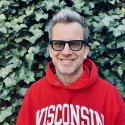Grass-roots effort attracts researchers
Astrophysicists Keivan Stassun and Eric Wilcots are minorities working in an area of research and teaching in which minorities are underrepresented. But they say it doesn’t have to be that way.
So when Stassun, a Hubble postdoctoral fellow, is not studying the life cycles of stars, and Wilcots, associate professor of astronomy, is not searching for clues into how galaxies are formed, both engage in a terrestrial search for qualified undergraduates of color to fill summer research opportunities on the UW–Madison campus.
“We are coming up with ways to identify qualified, minority students to become involved in our departments, and making it clear that these opportunities are available at no cost,” Stassun says.
Both researchers recall the wonderful undergraduate experiences they had at prestigious research institutions — Stassun at the University of California, Berkeley, and Wilcots at Princeton University.
They participated in a vast array of research opportunities not often available to minority undergraduates attending smaller schools, especially those that are predominantly African American and Hispanic. That can be a big setback in the highly competitive graduate school application process, which emphasizes research experience. The problem is a deep concern for both men.
“It’s a question of opportunity. Undergraduates at UW–Madison and other large institutions have plenty of research opportunities. But at smaller institutions, these opportunities are much rarer. And that’s a real hindrance to these students,” Wilcots says.
A chance to make a difference came from a National Science Foundation grant last year that funded a joint program in the astronomy and physics departments, called the Research Experience for Undergraduates in Astrophysics.
Program director Robert Benjamin says the program was created to get talented undergraduates — especially minorities — interested in UW–Madison graduate programs as well as astrophysics as a career.
“One of our major goals was to recruit minority students at colleges with few research opportunities and getting them to apply to graduate school,” Benjamin says.
The 10-week program is designed to provide undergraduates with essential research experience, working side-by-side with researchers like Stassun and Wilcots. Students are provided with housing and paid a stipend.
But simply making the program available did not completely address the problem. Stassun and Wilcots realized that a major recruitment effort was needed.
With financial support from the Graduate School, the two began spending much of their free time traveling to various universities. They also distributed information at the conventions for the National Society of Hispanic Physicists and the National Society of Black Physicists.
“This is really the best way to go out and find these students,” Benjamin says. “But the difficulty is that one person can’t do it all, so you have to have faculty and staff who are energized to go out and recruit.”
Their efforts seemed to pay off during last summer’s first installment of the REU in Astrophysics program. Of the nine participants, three were minorities who had been recruited by Stassun and Wilcots. If the students choose to attend graduate school, their summer experiences will mean a big boost in what they offer an institution. It may also point them in the direction of UW–Madison.
“I would love it if they would apply for graduate school at UW–Madison,” Benjamin says. “But if they apply anywhere, I would be happy.”
One of last summer’s success stories is Kurt Soto, a Hispanic student who was recruited by Stassun from the small community college he attended in southern California. After completing the program, Soto transferred to Stassun’s alma mater, UC Berkeley, where he is declaring a major in astrophysics.
Both Stassun and Wilcots, who are already recruiting researchers for next summer, hope they are playing a small role in increasing minority representation in their fields of research — both on the UW–Madison campus and elsewhere.
“In time, we hope that our name will be circulated around schools where it hasn’t been circulated before,” Wilcots says. “And that’s good for the university as a whole.”
Tags: diversity



